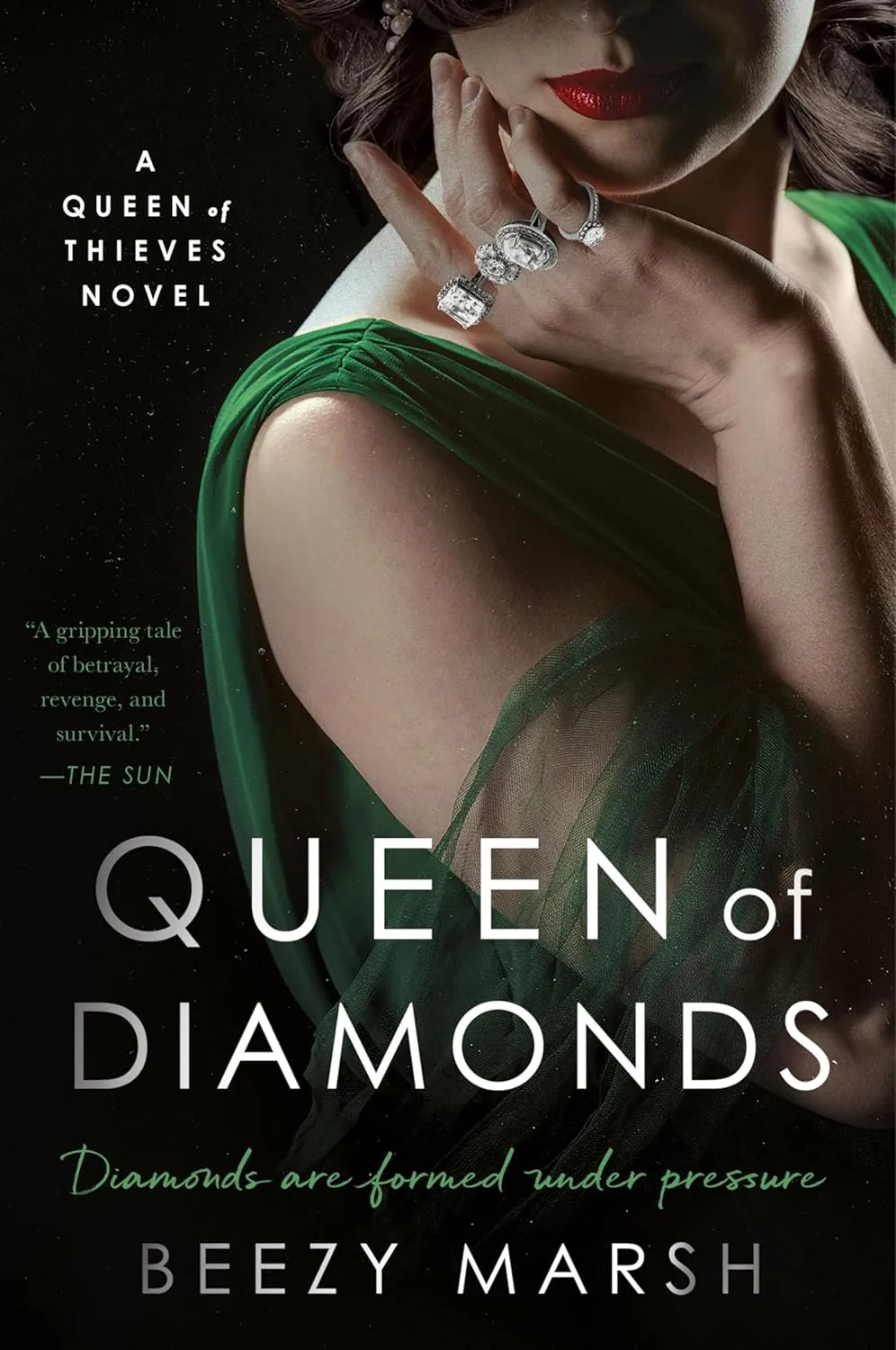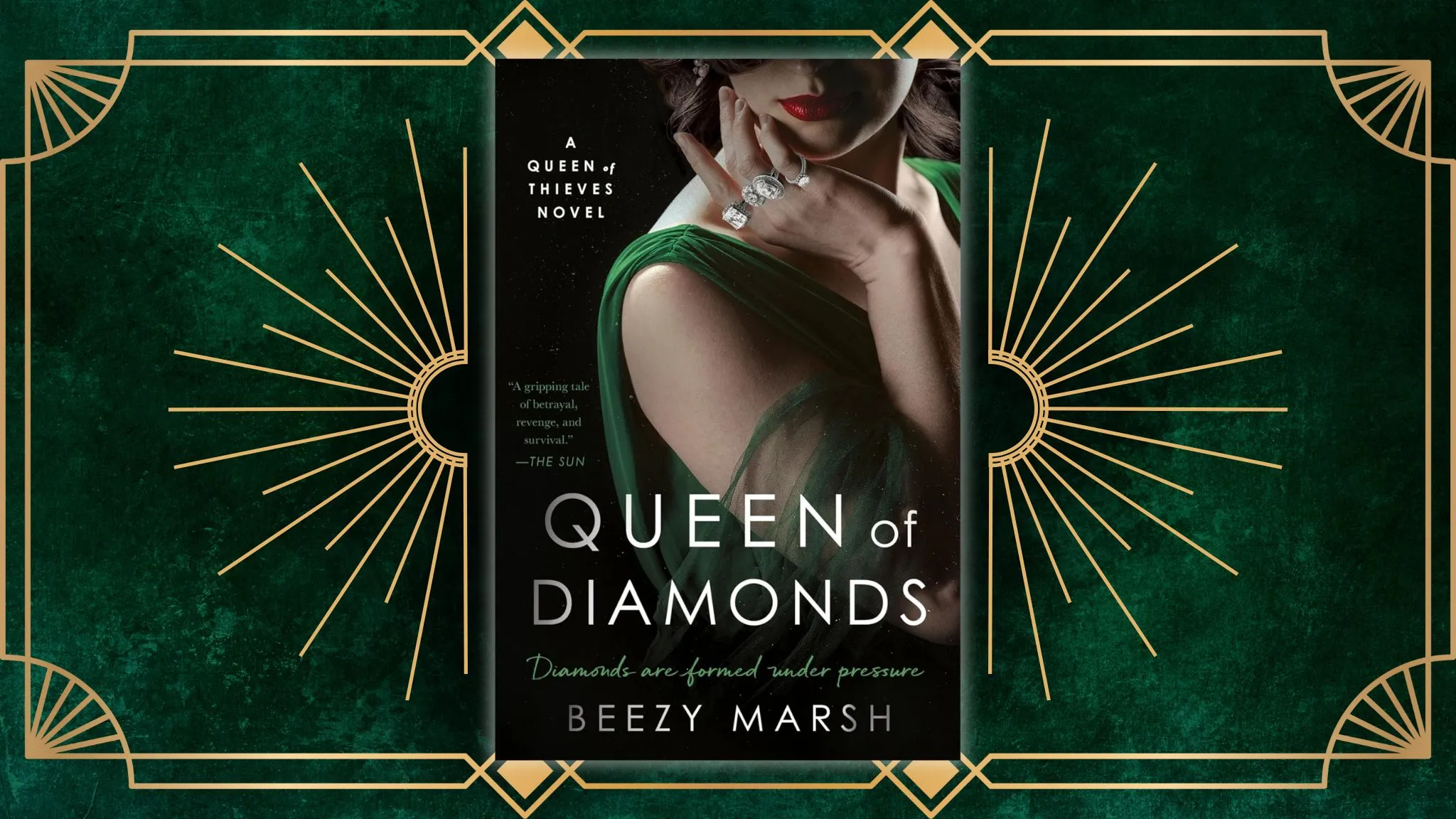Queen of Diamonds by Beezy Marsh
Beezy Marsh has effectively and objectively brought these fascinating women and their shoplifting syndicate to vivid life.
Queen of Diamonds completes Beezy Marsh’s trilogy of bold, exciting historical crime fiction novels that began with Queen of Thieves, set in post-WWII London, and followed by Queen of Clubs which takes place a decade later as it continues to follow the exploits of the shoplifting gang leader and nightclub owner Nell. The present novel reaches back in time to 1898 switching back and forth fluidly from turn-of-the-20th century Victorian England to the glitz and glamor of the Roaring 20s.
This series was inspired by a real-life, well-organized crime syndicate of female shoplifters who were called “The 40 Thieves”. Another moniker dubbed by the press was “The 40 Elephants” in reference to their origins in the slums of the Seven Dials neighborhood within the Elephant and Castle District in the West End of London. In fact, over 70 gang members who operated in the 1920s and 1930s have been identified through anecdotes and criminal records. Various forms of this ring of thieves existed since about 1873 up into the late 1950s.
Award-winning journalist, editor and best-selling author Beezy Marsh has a rare gift for finding true crime stories drawn from period newspapers that become the kernels of richly imagined, polished works of fiction about impoverished, slum-dwelling women who seize control of their lives to change their destinies through innovative albeit illegal means.
A Time When Crime Was the Better Option
Options were few for even the hardest-working women from the poorer classes. England lacked a welfare state and proffered neither a hand up nor a hand out. Educational opportunities were virtually nonexistent and most professions were not open to women, aside, of course, from the “oldest profession.”
Even if a husband drank or gambled the family wages away, women were subservient and were expected to turn over their meager earnings to their men. Single women might find work as servants which paid a pitifully low wage but did provide room and board. If the head of the household or a son impregnated a maid, they were summarily fired without references.
Several characters in Queen of Diamonds work in a jam factory suffering from heat generated by the canning process, exhaustion from long hours as well as dangerous working conditions and predatory supervisors.
Sewing piecework at a sweatshop or at home and other menial dead-end factory jobs were to be had without the possibility of any kind of advancement. Crime, however, did pay, sometimes ten times as much as a man’s weekly wage.
Women Skilled in Slight-of-Hand and Diversion
The commonly used slang term for a shoplifter was “hoister.” The voluminous clothing of the late Victorian era through the early 1920s was modified by talented seamstress gang members to include hidden pockets of varying sizes. Loot was hidden inside coats, skirts and bloomers with smaller items tucked into or under cummerbunds, muffs and hats.
These specialized garments could accommodate expensive goods ranging from jewelry to fur coats. Hoisters were aided by the generally accepted store policy that afforded their women customers privacy in dressing rooms which adhered to the standards of modesty. Communal dressing rooms without curtains or partitions as is later found in Loehmann’s Department Stores were unknown in that era.
The women worked in pairs to ensure each had a lookout, or small groups who could create a diversion which was particularly effective in jewelry stores allowing the thief to substitute a well-made fake ring or brooch for gems, or even to grab entire trays of valuable rings. These women trained for this profession and planned for the larger heists. They practiced sleight-of-hand and were expert pickpockets whose skills would have impressed Charles Dickens’ fictional Fagin.
An Endless Cycle of Crime and Punishment
The stolen goods when fenced could support their entire family and give a woman greater independence and self-determination with the caveat that getting caught meant prison sentences in grim Holloway Prison. If the presiding judge was in a bad mood or the accused offended him in some manner, the sentence could be longer or result in harsher punishment including incarceration with hard labor specified and no parole possible.
Many women would return repeatedly to a life of crime after being released from jail preferring the even temporary escape from poverty, while some were fortunate and were never apprehended.
The 40 Thieves dressed fashionably, were always clean, well-groomed and worked hard to emulate “posh” speakers to avoid suspicion and pass as legitimate customers in the better department stores such as Harrods, Selfridges and Liberty.
Strict Rules to Protect the Gang — and Yourself
The gang adhered to strict rules and demanded absolute secrecy and loyalty from its members and their associates including their fences who likewise profited from their adroitness in thievery. Violations would result in enforcement through violence. An invariable rule dictated that all plunder must be delivered to the ringleader who managed its disposition and then distributed their share.
The 40 Thieves were, in a very real sense, a successful cooperative, even though in a left-handed endeavor. To help avoid detection, the women were forbidden to keep distinctive items, particularly fur coats or expensive clothing that bore the labels of the high-end stores they pilfered from. When theft in the London stores became too hot and members began to be identified as suspects, the gang branched out into other cities scattered throughout England.
In Queen of Diamonds, Alice Diamond was betrayed and jailed when her partner, the petite and pretty Kate Felix, insisted on wearing a rare chinchilla coat stolen earlier in the day from a well-known furrier, then was photographed in it while partying at a popular nightclub. This careless disobedience resulted in harsh sentences after the almost inevitable arrest and trial.
Two Great Women Vividly Brought to Life
Beezy Marsh has brought to light the line of succession between two real crime queens although she has deftly fictionalized the details of the women who inspired this fantastic tale.
Mary Carr, also known as Polly, and later as the character Pearlie in this exciting novel, was a rather lovely young woman with fine features and luxuriant hair who through careful observation learned to emulate the walk, manner and speech of the upper classes. At various times she was a Covent Garden flower seller, an artist’s model who had been the muse of the president of the Royal Academy of Arts, a blackmailer, con artist, thief and undisputed gang leader known as “The Queen of Thieves”. Her richly imagined rise and ultimate fall is well depicted by the talented author.
She was succeeded by Alice Diamond, daughter of minor criminal Thomas Diamond and his wife Mary Ann Black. Alice was a teenager when she was first arrested for stealing chocolates in 1912.
Alice was an imposing figure, exceptionally tall for the era with her height estimated in a range of 5’9” to 6’. She was as strong as a man, physically powerful and had an iron fist in a fight. When she later found success as a jewel thief, she wore heavy diamond rings on the fingers of both hands which effectively served as brass knuckles. She became identified as the new “Queen of the 40 Thieves” as early as 1915.
The sparsely documented details of Alice’s real life have been exquisitely embellished for the readers of this gripping work of fiction. Beezy Marsh has effectively and objectively brought these fascinating women and their shoplifting syndicate to vivid life. These headline makers of the day might well be forgotten without her journalist’s eye for a timeless good tale.
 Beezy Marsh is an international #1 and Sunday Times top-ten best-selling author who puts family and relationships at the heart of her writing. She believes that ordinary lives are extraordinary. She is also an award-winning journalist, who has spent more than 20 years making the headlines in newspapers including The Daily Mail and The Sunday Times. She began her career as a writer after graduating from Leeds University with a Joint Honours degree in English Literature and French. She was Women’s Editor on The Northern Echo in the North East, where she grew up, winning awards for her reporting before moving to The Daily Mail, where as Health Correspondent she was nominated for a National Press Award for her investigations. Her historical novels featuring the gritty lives of working-class women in the first half of the twentieth century have spent six weeks in the Sunday Times top ten bestseller list in the U.K. and nine weeks at the coveted #1 slot in Canada. She is married, with two sons, and lives in Oxfordshire with a never-ending pile of laundry.
Beezy Marsh is an international #1 and Sunday Times top-ten best-selling author who puts family and relationships at the heart of her writing. She believes that ordinary lives are extraordinary. She is also an award-winning journalist, who has spent more than 20 years making the headlines in newspapers including The Daily Mail and The Sunday Times. She began her career as a writer after graduating from Leeds University with a Joint Honours degree in English Literature and French. She was Women’s Editor on The Northern Echo in the North East, where she grew up, winning awards for her reporting before moving to The Daily Mail, where as Health Correspondent she was nominated for a National Press Award for her investigations. Her historical novels featuring the gritty lives of working-class women in the first half of the twentieth century have spent six weeks in the Sunday Times top ten bestseller list in the U.K. and nine weeks at the coveted #1 slot in Canada. She is married, with two sons, and lives in Oxfordshire with a never-ending pile of laundry.

Publish Date: 1/14/2025
Genre: Fiction, Historical Fiction
Author: Beezy Marsh
Page Count: 304 pages
Publisher: William Morrow Paperbacks
ISBN: 9780063342750

